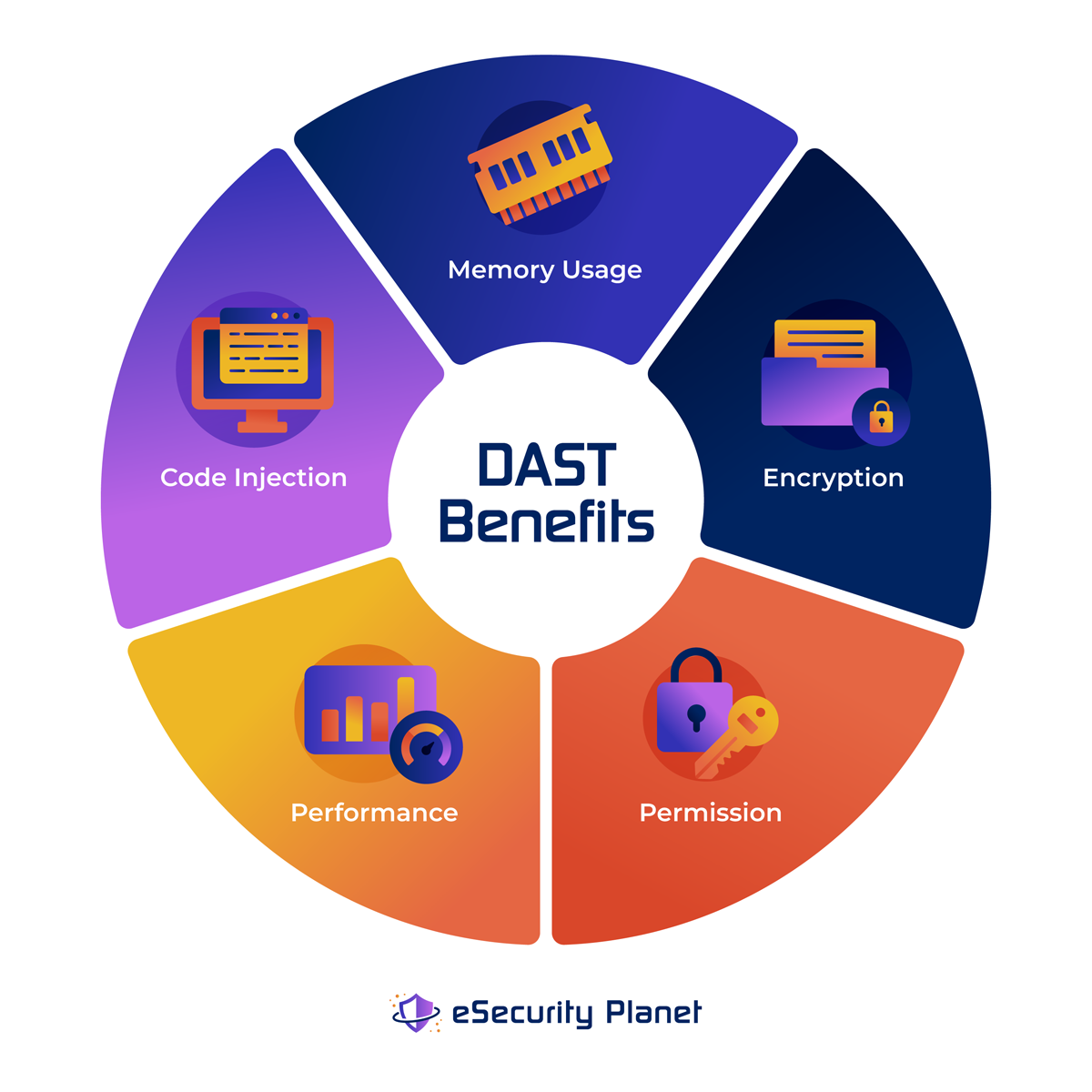Dynamic Application Security Testing (DAST) combines elements of pentesting, vulnerability scanning and code security to evaluate the security of web applications.
The cyber security team adopts the role of a simulated hacker and expertly scrutinizes the application’s defenses, thoroughly assessing its vulnerability to potential threats. By doing this, DAST helps determine how secure the web application is and pinpoint areas that need improvement.
- Why is DAST Important for Application Security?
- How Does DAST Work?
- 6 Pros of DAST
- 4 Cons of DAST
- What Is the Difference Between DAST, SAST, IAST and SCA?
- Top DAST Tools
- Bottom Line: Dynamic Application Security Testing (DAST)
Why is DAST Important for Application Security?
As cyber attacks grow increasingly sophisticated, DAST has become essential for maintaining web application security. It simulates real-world hacking efforts and assists in identifying flaws and vulnerabilities. This helps enterprises to address possible risks before they can be exploited by proactively assessing the application’s security and improving code and overall security posture to protect critical data.
Regular DAST assessments help businesses stay one step ahead of potential risks and contribute to the continual development of secure applications. Enterprises can ensure a stable and resilient environment for their users and stakeholders by continuously evaluating and enhancing their web application security.
How Does DAST Work?
DAST works by simulating the activities of hackers and scanning for vulnerabilities to find potential attack paths and make web applications as secure as possible. By pretending to be a hacker and scanning web applications and emulating hacking techniques, an enterprise’s security team can find the holes and vulnerabilities that might otherwise be used in a cyber attack. The security team examines the application from the outside, attempting to exploit vulnerabilities and assessing the effectiveness of defensive measures. DAST tools employ various techniques such as injection attacks, cross-site scripting (XSS) attempts, and other common attack vectors to identify potential weaknesses.
Security testers can use vulnerability scanning, pentesting and code security tools to help them test the application’s security.
See the Top Application Security Tools & Software
6 Pros of DAST
DAST plays an important role in ensuring the security of web applications, where vulnerabilities can expose critical data to the internet. Here are some of the pros and benefits of DAST security practices.

- Real-world simulation: DAST mimics actual hacking techniques, providing a realistic assessment of application security.
- Comprehensive coverage: DAST tests the entire application, including complex interactions, APIs (application programming interfaces), and integrations, ensuring a thorough security assessment.
- Rapid identification of vulnerabilities: DAST tools and solutions can quickly pinpoint exactly where potential security flaws are. This allows for immediate remediation and reduces the window of exposure.
- Lower rate of false alerts: By minimizing the occurrence of false alarms, DAST provides more precise and reliable results, reducing the number of false positives.
- Compatibility with diverse programming languages: With its ability to seamlessly assess the security of web applications developed in a range of programming languages, DAST offers flexibility and effectiveness across different programming frameworks.
- Rapid reevaluation of patched vulnerabilities: Through quick reassessment of resolved vulnerabilities, DAST allows organizations to promptly validate the effectiveness of their patches and ensure that they are no longer exploitable.
See the Best Patch Management Software & Tools
4 Cons of DAST
Despite the benefits, DAST isn’t without costs or limitations. Here are four to consider.
- Limited visibility into source code: Since the external attack nature of DAST restricts its ability to thoroughly analyze the source code, it might potentially miss certain vulnerabilities that require access to the code for detection.
- Impact on application performance: The scanning process of DAST tools can occasionally strain an application’s resources, leading to a potential performance degradation during the testing phase. For critically important applications, this is no small issue, and testing should be done during off-peak hours if possible.
- Delayed CI/CD pipeline results: DAST assessments may introduce delays in the continuous integration/continuous deployment (CI/CD) pipeline, potentially impeding the timely release of application updates or features.
- Potential need for manual testing: DAST scans may generate false positives or miss certain vulnerabilities, which will require additional manual verification to ensure accurate results and avoid overlooking potential security risks.
DAST, SAST, IAST and SCA: What Are the Differences?
DAST and SAST (static application security testing) are complementary methods of application security testing. SAST looks at the program’s source code to find possible security weaknesses before deployment, whereas DAST focuses on external analysis of the application and attempts to attack vulnerabilities in real-time.
While SAST offers insights on the design and organization of the code, DAST assesses the behavior of the program during runtime. Organizations frequently utilize a mix of the two approaches, each of which has advantages and disadvantages, to provide full security coverage.
Interactive application security testing (IAST) combines both DAST and SAST approaches, while software composition analysis (SCA) can also address configuration issues with applications that can potentially be exploited. There are also software dependencies and libraries that have known vulnerabilities, which is where vulnerability management capabilities fit in.
See the Top Vulnerability Management Tools
Top 3 DAST Tools

Invicti
Invicti, formerly known as Netsparker, is renowned for its advanced scanning technology and comprehensive coverage. It offers accurate detection of vulnerabilities, including complicated issues, and provides detailed reports for immediate and efficient remediation. It has a user-friendly interface and robust automation capabilities, making it one of the most popular choices among security professionals.

Veracode
Veracode is recognized for its comprehensive application security platform, which includes dynamic scanning capabilities. It combines DAST with static analysis (SAST) and software composition analysis (SCA) to provide a holistic approach to application security. Veracode’s industry-leading accuracy, scalability, and integration capabilities make it a preferred choice for organizations seeking end-to-end security testing solutions.

Acunetix
What makes Acunetix stand out is its powerful scanning engine and comprehensive vulnerability detection. It offers a wide range of automated security tests, including DAST, to identify common and advanced web application vulnerabilities. Its intuitive interface, robust reporting features, and extensive checks make it one of the top choices for enterprises seeking for effective web application security testing.
Also read:
Bottom Line: Dynamic Application Security Testing (DAST)
Maintaining web application security in today’s dynamic threat environment requires equally dynamic security approaches, so an enterprise’s web application security strategy must incorporate DAST techniques. DAST offers a realistic and thorough evaluation of application security by simulating actual hacking attempts, enabling enterprises to proactively detect weaknesses. Enterprises can make their application security coverage even more complete by integrating DAST with other security testing methodologies like SAST.
There are DAST products that are readily available that come with powerful scanning methods, precise vulnerability identification, and user-friendly interfaces. Invicti, Veracode, and Acunetix are a few of DAST solutions to consider, but code and application security tools are always evolving and other options exist too.
Adding DAST to an organization’s security plan will improve security posture, safeguard important data, and provide a secure environment for users and stakeholders.
Read next: Top Web Application Firewall (WAF) Solutions




